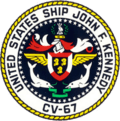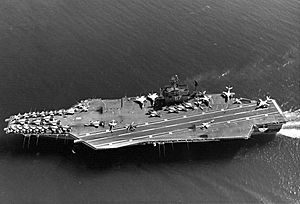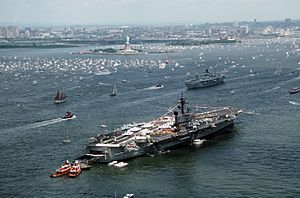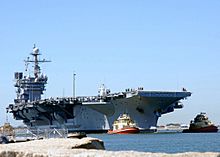USS John F. Kennedy (CV-67) facts for kids

USS John F. Kennedy leaving NS Mayport, Florida in November 2003
|
|
| Class overview | |
|---|---|
| Name: | John F. Kennedy-class |
| Builders: | Newport News Shipbuilding |
| Operators: | |
| Preceded by: | Kitty Hawk class and Enterprise class |
| Succeeded by: | Nimitz class |
| In commission: | 7 September 1968 – 1 August 2007 |
| History | |
| Name | John F. Kennedy |
| Namesake | John F. Kennedy |
| Awarded | 30 April 1964 |
| Builder | Newport News Shipbuilding |
| Laid down | 22 October 1964 |
| Launched | 27 May 1967 |
| Sponsored by | Caroline Kennedy |
| Christened | 27 May 1967 |
| Commissioned | 7 September 1968 |
| Decommissioned | 23 March 2007 |
| Refit | 1984 |
| Stricken | 16 October 2009 |
| Motto |
|
| Nickname(s) | "Big John" (unofficially: "Bldg 67", "Can Opener", "Jack the Tin Can Killer") |
| Fate | Designated for dismantling |
| Badge | |
| General characteristics | |
| Type | Aircraft carrier |
| Displacement |
|
| Length | 1,052 ft (321 m) overall, 990 ft (300 m) waterline |
| Beam | 252 ft (77 m) extreme, 130 ft (40 m) waterline |
| Height | 192 ft (59 m) from top of the mast to the waterline |
| Draft | 36 ft (11 m) maximum, 37 ft (11 m) limit |
| Installed power |
|
| Propulsion |
|
| Speed | 34 knots (63 km/h; 39 mph) |
| Capacity | 5,000+ |
| Complement | 3,297 officers and men (without jet commands & crews) |
| Armament |
|
| Aircraft carried | 80+ |
The USS John F. Kennedy (CV-67) was a huge aircraft carrier that served in the United States Navy. It was the last large carrier built for the Navy that used regular engines, not nuclear power. The ship was named after John F. Kennedy, who was the 35th President of the United States. People often called the ship "Big John."
After almost 40 years of service, the John F. Kennedy was officially taken out of service on August 1, 2007. It is now kept in Philadelphia. For a while, there were plans to turn it into a museum ship, but in 2017, the Navy decided it would be taken apart instead. A new aircraft carrier, the John F. Kennedy (CVN-79), will carry on its name.
Contents
The Story of USS John F. Kennedy
Building and First Voyages
The ship's construction started on October 22, 1964, at Newport News Shipbuilding. It was launched on May 27, 1967. Caroline Kennedy, who was 9 years old and the daughter of President Kennedy, helped christen the ship. The John F. Kennedy officially joined the Navy on September 7, 1968.
The John F. Kennedy was a special version of the earlier Kitty Hawk-class aircraft carriers. It was supposed to be the fourth ship of that class. But during its building, so many changes were made that it became its own unique class. The ship was first planned to be nuclear-powered. However, this plan changed, and it was built with regular engines instead. The ship's "island" (the control tower) looks a bit different from the Kitty Hawk class. It has slanted funnels to keep smoke away from the flight deck. The John F. Kennedy is also about 17 feet (5.2 meters) shorter than the Kitty Hawk class ships.
In April 1969, the John F. Kennedy sailed to the Mediterranean Sea. This was its first big trip. It arrived in Rota, Spain, on April 22, 1969.
Adventures in the 1970s
The John F. Kennedy's first few trips were to the Mediterranean Sea. This was a busy area because of problems in the Middle East. During the 1970s, the ship was updated. It was made ready to handle newer planes like the F-14 Tomcat and the S-3 Viking.
In October 1973, the John F. Kennedy helped the Navy respond to the Yom Kippur War in the Middle East. In 1974, it won an award for being the best ship in the Atlantic Fleet for its readiness.
On November 22, 1975, the John F. Kennedy had a collision with the cruiser Belknap. The Belknap was badly damaged, and seven of its crew members died. One crew member on the John F. Kennedy also died from smoke.
Later, on September 14, 1976, another ship, the destroyer Bordelon, crashed into the John F. Kennedy during a nighttime refueling. The Bordelon was so damaged that it had to be taken out of service. On the same day, an F-14 Tomcat plane fell off the John F. Kennedy's flight deck. This happened after a problem with the catapult system. Both pilots got out safely. The plane carried special missiles, and there was a race between the US and Soviet navies to find it. The US Navy found the plane and its missiles.
In 1979, the John F. Kennedy had its first major repair work, which finished in 1980. Also in 1979, the ship won its second readiness award.
Missions in the 1980s
On August 4, 1980, the John F. Kennedy left Norfolk, Virginia, for another trip to the Mediterranean Sea. In January 1982, it sailed to the Indian Ocean for the first time. It even visited Perth, Western Australia.
In October 1983, the John F. Kennedy was sent to Beirut, Lebanon. This was after a bombing killed many US military members there. The ship spent months patrolling the area. On December 4, 1983, planes from the John F. Kennedy and another carrier bombed targets in Beirut. This was a response to US planes being fired upon. During this mission, two US planes were shot down. One pilot died, and another was captured but later released.
In 1984, the ship went into drydock for a year and a half for major repairs and upgrades. In 1985, the John F. Kennedy won an award for having the best maintenance department in the entire Department of Defense.
In July 1986, the John F. Kennedy took part in a big naval parade to celebrate the Statue of Liberty's re-dedication. It was the lead ship for all the others. Then, in August, it went on another mission to the Mediterranean. This included operations near Lebanon because of rising terrorist activities. The ship returned in March 1987 and went into drydock again for more upgrades and repairs.
In August 1988, the John F. Kennedy was on another mission. Two MiG-23 fighter jets from Libya approached the carrier. The John F. Kennedy launched two F-14 Tomcats to stop them. The US planes shot down both Libyan aircraft.
The 1990s and Desert Storm
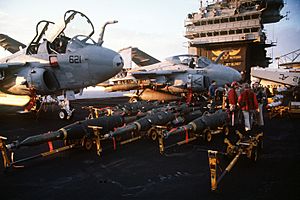
In August 1990, the John F. Kennedy was called to prepare for Operation Desert Shield. The ship quickly loaded fuel, weapons, and equipment. It left the United States ready for combat faster than any ship since the Vietnam War. It became the main ship for the Red Sea Battle Force.
On January 17, 1991, the John F. Kennedy's planes began the first attacks against Iraqi forces as part of Operation Desert Storm. The ship launched over 2,900 missions and dropped more than 3.5 million pounds of bombs. On February 27, 1991, a cease-fire was declared. The John F. Kennedy then began its journey home, arriving in Norfolk on March 28, 1991.
After this, the ship had more maintenance and repairs. It was also updated to handle the newer F/A-18C/D Hornet planes. The John F. Kennedy then went on its 14th mission to the Mediterranean. It helped with training exercises in case of intervention in Yugoslavia. After this, the ship went to the Philadelphia Naval Shipyard for a two-year major overhaul. Once finished, its new home port became Mayport Naval Station in Jacksonville, Florida.
In October 1995, the John F. Kennedy was designated as a "reserve carrier." This meant it would have a mixed crew of active duty and reserve sailors. Its main job was to be ready if needed quickly and to support training. However, the reserve program did not get enough funding. After the September 11 attacks in 2001, this idea was stopped. The John F. Kennedy went back to being a full active-duty carrier.
In 1996, the John F. Kennedy visited Dublin, Ireland. More than 10,000 people visited the ship. The visit honored President John F. Kennedy and Commodore John Barry, an Irish-born officer who helped start the US Navy. During this visit, strong winds caused a hole in the ship's hull.
The ship's 15th Mediterranean mission included time in the Persian Gulf. One night, two Iranian F-14 planes flew towards the ship. Another US Navy ship warned them to turn away, which they did. The John F. Kennedy returned in time for Fleet Week in New York City.
Before its 16th mission in September 1999, the John F. Kennedy helped rescue the crew of a tugboat during Hurricane Floyd. Then it headed to the Middle East. It became the first US aircraft carrier to visit Al Aqabah, Jordan. The King of Jordan even visited the ship. The John F. Kennedy then supported Operation Southern Watch. It was the only conventionally powered US carrier at sea at the end of 1999. It returned to Mayport on March 19, 2000.
The 2000s and Retirement
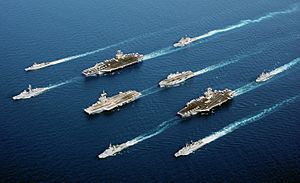
During its last updates, the John F. Kennedy became a test ship for a new system called Cooperative Engagement Capability. This system allowed the ship to hit targets from farther away.
In 2001, before a mission, the John F. Kennedy was found to have problems. Two aircraft catapults (used to launch planes) and three aircraft elevators (used to move planes) were not working. Because of this, its captain and two other leaders were replaced.
When the September 11 attacks happened in 2001, the John F. Kennedy was ordered to help with Operation Noble Eagle. It provided air security along the East Coast, including Washington, D.C..
In the first half of 2002, planes from the John F. Kennedy dropped 31,000 tons of bombs on Taliban and al Qaeda targets. This was part of Operation Enduring Freedom. In August 2002, the John F. Kennedy visited Tarragona in Spain.
In July 2004, the John F. Kennedy collided with a small boat called a dhow in the Persian Gulf. There were no survivors on the dhow. After this, the ship's commanding officer was replaced. The carrier itself was not damaged. However, two jet fighters on the deck were damaged when one plane slid into another as the ship made a sharp turn to avoid the dhow.
The John F. Kennedy was very expensive to maintain. Because of budget cuts and new Navy strategies, it was decided to retire the ship. On April 1, 2005, the Navy announced that the ship's planned 15-month overhaul was canceled.
Before being decommissioned, the ship made several stops for the public to say goodbye. This included a visit to its "homeport" of Boston Harbor. The John F. Kennedy was decommissioned in Mayport, Florida, on March 23, 2007.
The ship had a special cabin decorated by Jacqueline Kennedy Onassis. This cabin was taken apart to be rebuilt at the National Naval Aviation Museum in Naval Air Station Pensacola, Florida.

The former John F. Kennedy was towed to Norfolk, Virginia, in July 2007. It then moved to the Naval Inactive Ship Maintenance Facility in Philadelphia on March 22, 2008. It is currently part of the reserve fleet there.
What's Next for the Ship?
In November 2009, the Navy considered donating the John F. Kennedy to become a museum. Groups from Rhode Island and Portland, Maine, tried to get the ship. However, in January 2011, the Portland City Council decided not to continue with the project.
In 2014, the Rhode Island Aviation Hall of Fame was still working to get the ship. The John F. Kennedy and the Kitty Hawk are the last two non-nuclear carriers that could become museum ships. Nuclear carriers are too difficult to turn into museums because their reactors must be removed. In October 2017, it was announced that the Kitty Hawk would be scrapped. This left the John F. Kennedy as the last possible carrier for a museum.
However, in late 2017, the Navy decided that the John F. Kennedy would also be taken apart. Despite this, several groups are still trying to convince the Navy to change its mind. They hope to get the ship to become a museum.
Call Sign
| ICS International radio call sign of USS John F. Kennedy (CV-67) |
|||
| November | Juliet | Foxtrot | Kilo |
See also
 In Spanish: USS John F. Kennedy (CV-67) para niños
In Spanish: USS John F. Kennedy (CV-67) para niños


